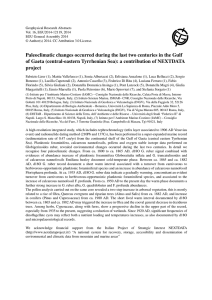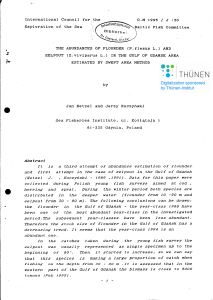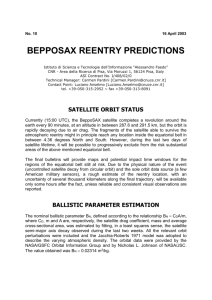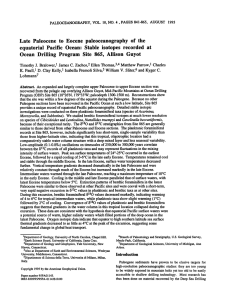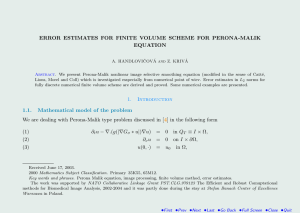Lirer et al_SGI-SIMP_2014
advertisement
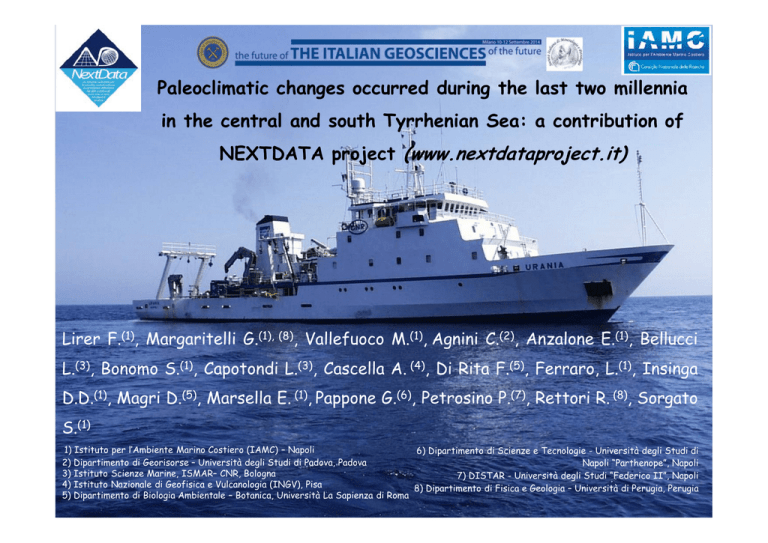
Paleoclimatic changes occurred during the last two millennia in the central and south Tyrrhenian Sea: a contribution of NEXTDATA project (www.nextdataproject.it) Lirer F.(1), Margaritelli G.(1), (8), Vallefuoco M.(1), Agnini C.(2), Anzalone E.(1), Bellucci L.(3), Bonomo S.(1), Capotondi L.(3), Cascella A. (4), Di Rita F.(5), Ferraro, L.(1), Insinga D.D.(1), Magri D.(5), Marsella E. (1), Pappone G.(6), Petrosino P.(7), Rettori R. (8), Sorgato S.(1) 1) Istituto per l’Ambiente Marino Costiero (IAMC) – Napoli 6) Dipartimento di Scienze e Tecnologie - Università degli Studi di 2) Dipartimento di Georisorse – Università degli Studi di Padova, Padova Napoli “Parthenope”, Napoli 3) Istituto Scienze Marine, ISMAR– CNR, Bologna 7) DISTAR - Università degli Studi “Federico II”, Napoli 4) Istituto Nazionale di Geofisica e Vulcanologia (INGV), Pisa 8) Dipartimento di Fisica e Geologia – Università di Perugia, Perugia 5) Dipartimento di Biologia Ambientale – Botanica, Università La Sapienza di Roma How will climate in the future? How will marine ecosystem in the near future? How will adapt man to climate change in the near future? Necessity: the study of time series in order to understand the future changes Combining information from natural archives, documentary and instrumental data with evidence of past human activity obtained from historical, paleoecological, and archaeological records is of major relevance for our understanding of climate sensitivity, environmental response, ecological processes, and human impact. As has been shown above, temporally and spatially high-resolution climate information from marine archives is still Luterbacher et al., limited. (2012) - A Review of 2000 Years of Paleoclimatic Evidence in the Mediterranean Progetto di Interesse Strategico NEXTDATA: un sistema nazionale per la raccolta, conservazione, accessibilità e diffusione dei dati ambientali e climatici in aree montane e marine Sedimentary Archives and historical documents for the last 2000 years Luterbacher et al. 2012 modified cores NextData cores after MedClivar Subdivision of the last 2000 years 1708 Hondius,1677 Brueghel,1566 Fabris,1773 Subdivision of the last 2000 years Global warming warming Anthropocene warming Damon Second industrial revolution Dalton What are the marine areas suitable for recognising these climatic events occurring during the last 2000 years? The continental platform …a key area for monitoring the past climatic changes during the last 2000 years Mean Sediment.Rate Sicily Channel 2,5cm/100yr (600 m. w. depth) Gulf of Gaeta 9cm/100yr (120 m. w. depth) Gulf of Gaeta 13cm/100yr (93 m. w. depth) Tool: the planktonic foraminifera The planktonic foraminifera are commonly used as proxy for the paleoceanographic and sea-surface temperature reconstructions because they record the changes of the environmental parameters of the water masses in which they live (Bè & Tolderlund, 1971; Bè, 1977; Fairbanks et al., 1980; Hemleben et al., 1989; Ravelo et al., 1990; Le & Shackleton, 1994; Kucera et al., 2005). The study areas This work Lirer et al. (2013) Radionuclides 210Pb e Tefrochronology AMS 14C 137Cs High-resolution Chronology Oxygen stable isotopic correlation between cores C5 and C90 0,4cm/yr 0,08cm/yr Lirer et al. (2014) Planktonic foraminifera and δ18O G. ruber vs time (AD) δ18O G. ruber Comparison between south-central Tyrrhenian Sea and Gulf of Taranto for the last 2000 years Gulf of Gaeta Core C5_SW104 SST reconstructed from d 18O Globigerinoides ruber Temperature & Salinity Ottober 2013 from -80 a – 500 mbsf Comparison between SST from Salerno and Gaeta gulfs and Sun Spot numbers warming 1930 warming Damon Seconda rivoluzione industriale Blu - Sun spot Black- SST Gulf of Gaeta Dalton The shallow water environment represents a keysite to Conclusion document the climatic oscillations during the last 2000 years Turnover between carnivorous and herbivorous planktonic foraminifera represents an important tool for monitoring the climatic changes Six main climatic phases have been recorded: Roman Period Dark Age Medieval Classic Anomaly Little Ice Age Maunder: maxima in G. truncatulinoides left coiled Sporer and Wolf: peaks in cold planktonic foraminiferal species (G. scitula + N. pachyderma Industrial Period Stable climatic condition? Strong oligotrophic condition: maxima G. quadrilobatus Modern Warm Period Strong increase in sea surface productivity
